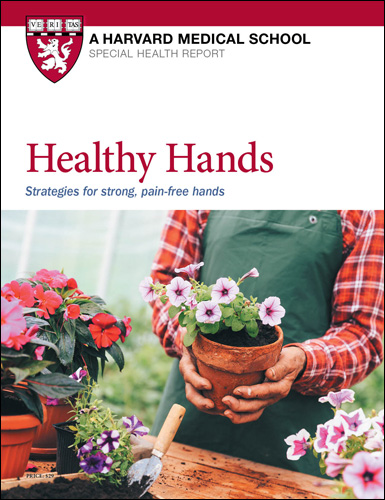Typing and tapping despite hand pain
Do stiff hands make it hard to use your smartphone or computer? Try these tips so you can keep using your devices.

Thanks to technology, the world is at your fingertips. All it takes is tapping on a smartphone, typing on a keyboard, or clicking with a mouse. That's not so easy, however, when it irritates underlying conditions, such as tendinitis or arthritis.
"The problem is the repetitive movement of your fingers on a keyboard or reaching and stretching your fingers on a mouse. With a phone, it's the repetitive movement with one hand and sustained grasping with the other hand," explains Eve Kennedy-Spaien, clinical supervisor of the Pain Management, Work Injury, and Integrative Medicine Programs at Harvard-affiliated Spalding Rehabilitation Hospital.
Consider the following strategies when hand pain or stiffness makes computer or smartphone use difficult, and check with your doctor to make sure these tips are right for you.
Distribute the work
Do you have a "hunt and peck" typing style? Do you text only with your thumb? That can lead to overuse injuries. Instead, distribute the work among your fingers and hands. "Alternate which fingers are doing the work," Kennedy-Spaien says. "If you only use a mouse with your right hand, try mousing left-handed. Or switch the hand you use to hold a smartphone."
Take breaks
Using a computer or smartphone is a sedentary activity. It keeps you from being active and restricts blood flow to your hands, which makes them stiffer and harder to move.
To combat it, take scheduled breaks before you feel the need to stop. "By the time your hands are complaining, you've already aggravated them. It takes longer to get the pain and stiffness under control, and you end up needing a longer break," Kennedy-Spaien says. "Take a five-minute break after 45 minutes of activity. Stand up, get a drink of water, or do anything that completely changes your position."
Stretch your wrists and hands
It's important to keep your wrists and hands limber. Stretch them periodically. Start at your wrists, keeping your forearms still and slowly moving your fists in circles. Next, gently open and close your fists, stretching your fingers if you can. "Make sure your fingers are aligned and moving together, and that no finger is going ahead of or lagging behind the others, which can happen when you have arthritis," Kennedy-Spaien advises.
Use heat or cold therapy
Heat and cold therapies have differing uses. Heat is soothing and relaxes muscles. It's helpful before typing or using your phone for an extended period. "It's good for stiffness but not swelling," Kennedy-Spaien says. "Moist heat gets deeper into the tissues and joints. You can get moist heat from warm hand soaks or using microwavable moist heat mittens."
Ice is an anti-inflammatory and a painkiller. "It's best for tendinitis or swollen, hot joints. It helps after you've been using your hands for a long time," Kennedy-Spaien says. Try an ice pack, cold therapy gloves (with gel packs you keep in the freezer), or a hand soak in icy water. Limit therapy sessions to 20 minutes, to avoid hurting your skin.
Avoid awkward hand positions
Holding or moving your hands in unnatural ways can cause pain. For example, maybe you're reaching for the mouse with only your wrist; twisting your wrist as you hold your smartphone; or propping your laptop on your fingers. All of those activities put pressure on the joints and small muscles. "Use your larger muscles — such as your whole arm to move your mouse — and keep weight off of your fingers," suggests Kennedy-Spaien.
Use helpful tools
Go easier on your hands and wrists by using some of the following tools.
"Virtual" assistants or voice-to-text features. Most computers and smartphones have features that allow you to type, text, or carry out commands by simply talking out loud. Don't know how to use them? Search for an instructive video on the Internet or ask a family member for a lesson.
A comfortable mouse. "You should be able to move the mouse without having to grasp it tightly or stretch your fingers out too wide," Kennedy-Spaien notes. Get a mouse that's bigger or smaller to fit you better, or try a vertical mouse that keeps your hand in a handshake position.
A wide-grip stylus. It's easy to hold and saves your fingers from tapping on a smartphone or tablet.
A smartphone holder. "A gooseneck holder enables you to adjust the height and angle," Kennedy-Spaien suggests.
Gel-filled wrist rests. Get them for your keyboard and mouse.
Get a comfy chair. Be sure it has good support and that you sit up straight in it. "The body is a dynamic chain," Kennedy-Spaien says. "When one part isn't in a good position, it affects the rest of the body, including your hands."
Image: © diego_cervo/Getty Images
About the Author

Heidi Godman, Executive Editor, Harvard Health Letter
Disclaimer:
As a service to our readers, Harvard Health Publishing provides access to our library of archived content. Please note the date of last review or update on all articles.
No content on this site, regardless of date, should ever be used as a substitute for direct medical advice from your doctor or other qualified clinician.
















